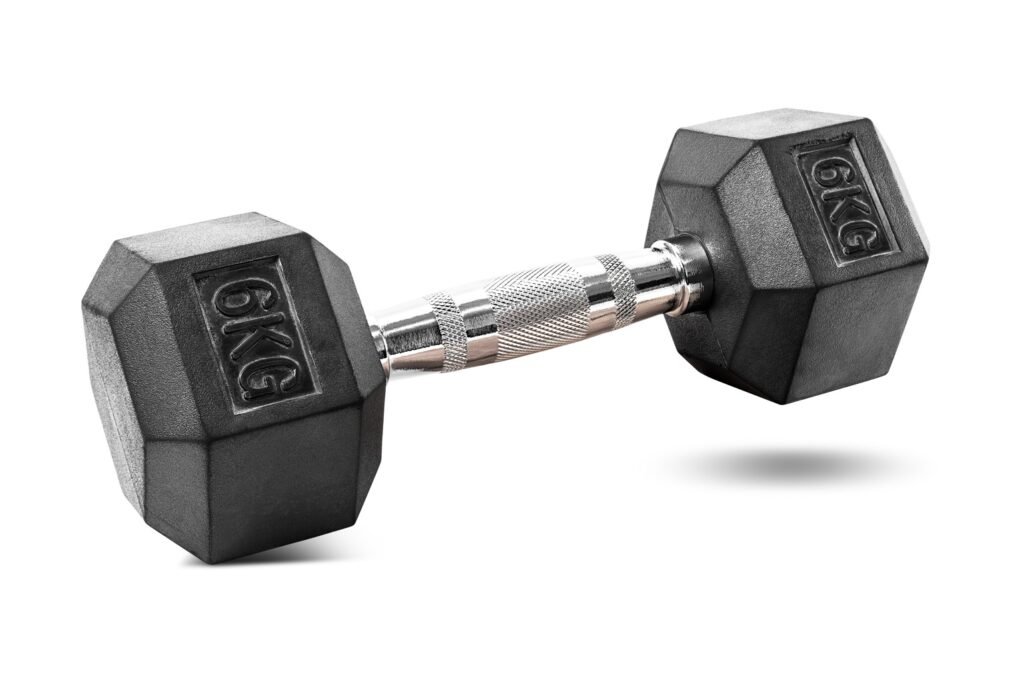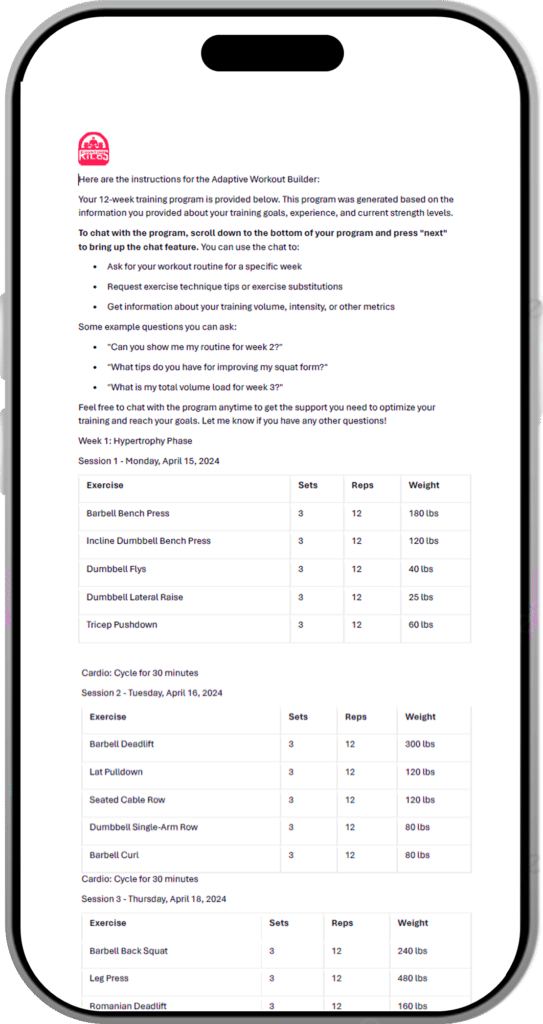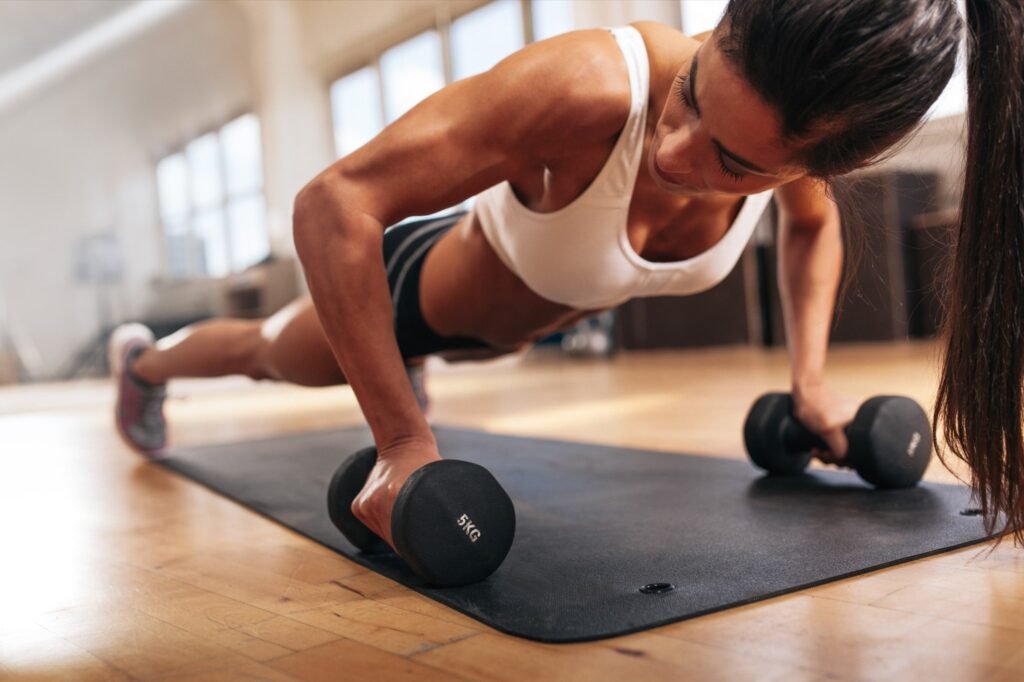In the world of chest exercises, dumbbell push-ups stand out as a superior variation that demands attention. While traditional push-ups have their merits, incorporating dumbbells into this classic move elevates its effectiveness to new heights.
As a fitness professional with extensive experience in strength training, I can attest to the unparalleled benefits of dumbbell push-ups. This guide will delve into why they’re a crucial addition to any serious chest workout routine, how they enhance muscle activation, and the proper techniques to maximize your results. Get ready to transform your upper body training with this powerful exercise.
But before we dive in deeper than a powerlifter’s squat, let’s break down what we’re going to cover:
Key Takeaways:
- Dumbbell push-ups are a game-changing variation of the classic exercise
- They offer greater range of motion
- Proper form is crucial for maximizing benefits and avoiding injury
- Various modifications exist for beginners and advanced athletes alike
- Incorporating dumbbell push-ups can significantly elevate your chest workout routine
Now, let’s get down to business and explore why dumbbell push-ups might just become your new favorite chest exercise.
Table of contents
Introduction to Dumbbell Push-Ups

Definition and Basic Concept
Dumbbell push-ups are exactly what they sound like – push-ups performed with your hands gripping dumbbells instead of being placed flat on the floor. It’s like giving your regular push-ups a VIP upgrade. The key difference? The dumbbells allow for a greater range of motion, which means more muscle engagement and potentially more gains.
Think of it this way: if regular push-ups are like driving a reliable sedan, dumbbell push-ups are like taking a sports car for a spin. Both will get you where you need to go, but one’s going to give you a bit more excitement along the way.
The benefits of incorporating dumbbells into your push-up routine are numerous. You’ll engage more muscle fibers, improve your stability, and add an element of versatility to your workouts. Plus, you’ll look pretty cool doing them – always a bonus, right?

Equipment Needed
Now, before you start rummaging through your garage for those dusty old dumbbells, let’s talk about what you actually need:
- Dumbbells: Obviously. But not just any dumbbells. For beginners, hexagonal dumbbells are your best bet. They’re stable and won’t roll away when you’re trying to impress that cute gym-goer across the room. As for weight, start light – maybe 5-10 pounds. You can always work your way up to the big boy weights later to add additional stretch.
- Exercise Mat (optional): While not strictly necessary, an exercise mat can make your workout more comfortable. Trust me, your wrists will thank you after a few sets.
And that’s it! No fancy equipment, no complicated setup. Just you, some dumbbells, and the burning desire to sculpt a chest that would make Michelangelo’s David jealous.
Benefits of Dumbbell Push-Ups
Enhanced Range of Motion
Alright, let’s get into of why dumbbell push-ups are the bee’s knees of chest exercises.
First off, the increased range of motion. When you’re gripping dumbbells, your chest has to work through a larger arc of movement compared to standard push-ups. It’s like the difference between a quick peck on the cheek and a full-on bear hug – one’s just more engaging, you know?
This extended range means you’re getting a deeper stretch in your pecs at the bottom of the movement and a fuller contraction at the top. It’s like giving your chest muscles a full spa day – they’re getting stretched, squeezed, and pampered all in one exercise.
But wait, there’s more! (I always wanted to say that.) Dumbbell push-ups don’t just work your chest. They’re also calling on your stabilizer muscles to join the party. Your shoulders, triceps, and even your core have to work overtime to keep you balanced on those dumbbells. It’s like trying to stand on a paddleboard – everything’s got to work together, or you’re taking an unexpected dip.
Improved Strength and Power
Now, let’s talk about strength gains. The instability created by the dumbbells is like trying to do push-ups on a mildly annoyed cat – challenging, but rewarding. This instability forces your muscles to work harder, which can lead to greater strength improvements over time.
But here’s where it gets really interesting. The strength you build doing dumbbell push-ups isn’t just confined to that exercise. It carries over to other chest exercises too. So, when you go back to your regular push-ups or hit the bench press, don’t be surprised if you’re suddenly pushing more weight than before. It’s like getting a free upgrade on your strength gains – who doesn’t love a good deal?
Versatility and Progression
One of the best things about dumbbell push-ups is their versatility. They’re like the Jack of all trades of chest exercises. Need to make it easier? Use smaller dumbbells. Want more of a challenge? Grab larger dumbbells or try single-arm variations. The possibilities are endless, much like my love for a good chest pump.
This versatility means you can easily incorporate dumbbell push-ups into various workout routines. Whether you’re doing a full chest day, an upper body circuit, or just want to spice up your regular push-up routine, dumbbell push-ups have got you covered.
And let’s not forget about unilateral training. By working each side independently, you can address any strength imbalances. It’s like being your own personal detective, uncovering and fixing any weak links in your chest armor.
| Aspect | Regular Push-Ups | Dumbbell Push-Ups |
|---|---|---|
| Range of Motion | Standard | Increased |
| Muscle Activation | Good | Enhanced |
| Stability Required | Moderate | High |
| Progression Options | Limited | Numerous |
| Unilateral Training | Not possible | Possible |
| Equipment Needed | None | Dumbbells |
Proper Form and Technique
Starting Position
Alright, let’s break down the perfect dumbbell push-up form. It’s like building a house – get the foundation right, and everything else falls into place.
First, place your dumbbells slightly wider than shoulder-width apart. Think of it as giving your chest room to breathe – you wouldn’t want to suffocate those pecs, would you?
Now, grip those dumbbells like they owe you money. Your palms should be facing each other, fingers wrapped around the handles. This neutral grip is key – it’s what allows for that extra range of motion we’ve been raving about.
As for body alignment, imagine you’re trying to make a perfectly straight line from your head to your heels. Engage your core like you’re bracing for a punch (don’t worry, I’m not actually going to hit you). Your glutes should be tight too – think of trying to crack a walnut between those cheeks. Too much? Maybe, but you get the idea.
Execution of the Movement
Now for the main event – the actual push-up.
Lower Phase (Eccentric): Slowly lower your body by bending your elbows. Keep them close to your body – we’re not trying to imitate a chicken here. Lower yourself until your chest is just about to touch the floor between the dumbbells. Feel that stretch in your pecs? That’s the magic happening.
Pushing Phase (Concentric): Push yourself back up to the starting position. Imagine you’re trying to push the earth away from you (spoiler alert: it won’t budge, but your muscles will thank you for the effort).
Key form cues to keep in mind:
- Keep your elbows tucked, not flared out like you’re trying to take flight.
- Squeeze your shoulder blades together at the bottom of the movement. It’s like you’re trying to hold a pencil between them.
- Maintain that straight body line throughout. No sagging hips or arched backs – we’re doing push-ups, not the limbo.
Common Mistakes to Avoid
Even the best of us (yes, even me) can make mistakes. Here are some common ones to watch out for:
- Flaring the elbows: This puts unnecessary stress on your shoulders. Keep those elbows tucked!
- Sagging hips: Your body should be as straight as my face when someone tells me they don’t like working out.
- Incomplete range of motion: Don’t cheat yourself out of gains. Go all the way down and all the way up.
- Holding your breath: Unless you’re trying to turn purple, remember to breathe. Exhale on the way up, inhale on the way down.
- Looking up: Keep your neck neutral. Staring at the ceiling won’t make the push-ups any easier, trust me.
Remember, maintaining proper form throughout the exercise is crucial. It’s like following a recipe – skip a step, and you might end up with a fitness equivalent of a burnt cake. Nobody wants that.
Variations and Progressions
Beginner Modifications
Not quite ready for full dumbbell push-ups? No worries, we’ve all been there. Here are some modifications to help you build up to the real deal:
- Elevated Dumbbell Push-Ups: Place the dumbbells on a raised surface like a bench or step. The higher the surface, the easier the exercise. It’s like training wheels for your chest workout.
- Knee Dumbbell Push-Ups: Perform the push-ups with your knees on the ground. It reduces the load but still allows you to practice the movement pattern.
- Negative Dumbbell Push-Ups: Lower yourself slowly from the top position, then use your knees to push back up. It’s like doing half the work, but still getting results.
Remember, mastering form is key before progressing. It’s like learning to walk before you run, except in this case, it’s learning to push before you… well, push harder.
Advanced Variations for Dumbbell Push-ups
Ready to kick it up a notch? Try these advanced variations:
- Single-Arm Dumbbell Push-Ups: Perform the push-up using only one arm. It’s like telling gravity, “Nice try, but I’m stronger.”
- Unstable Surface Dumbbell Push-Ups: Place the dumbbells on an unstable surface like a BOSU ball or stability disc. It’s like doing push-ups while trying to balance on a jellyfish – challenging, but effective.
- Plyometric Dumbbell Push-Ups: Push up explosively so your hands leave the dumbbells. Catch yourself on the way down and immediately go into the next rep. It’s like adding a little bounce to your routine – fun and effective.
Incorporating Dumbbell Push-Ups into Your Workout
Now, how do you fit these bad boys into your workout? Here are some ideas:
- As a primary chest exercise: Start your chest workout with 3-4 sets of dumbbell push-ups, 8-12 reps each.
- In a superset: Pair dumbbell push-ups with rows for a killer push-pull combo.
- As a finisher: End your chest workout with a burnout set of dumbbell push-ups. Go to failure and feel the burn!
For strength goals, stick to lower reps (5-8) with heavier dumbbells. For hypertrophy, aim for 8-12 reps. And for endurance, go for 15+ reps. Mix it up, keep your muscles guessing, and watch those gains roll in.

Safety Considerations and Precautions
Proper Warm-Up
Before you start pushing those dumbbells, let’s talk warm-up. Skipping your warm-up is like trying to run a marathon right after waking up – technically possible, but not recommended unless you enjoy pain.
Start with some light cardio to get the blood flowing. A few minutes of jumping jacks or a brisk walk will do. Then, move on to some dynamic stretches for your chest and shoulders. Arm circles, shoulder rolls, and gentle chest stretches are your friends here.
Here’s a quick warm-up routine:
- 2-3 minutes of light cardio
- 10-15 arm circles forward and backward
- 10-15 shoulder rolls
- 10-15 wall push-ups
- 10-15 seconds of doorway chest stretch on each side
Injury Prevention
Now, let’s talk about keeping you in one piece. Injury prevention is key – after all, you can’t build muscle if you’re nursing an injury on the couch.
- Gradual Progression: Don’t try to be a hero on day one. Start with manageable weights and gradually increase as you get stronger. Rome wasn’t built in a day, and neither is a chiseled chest.
- Proper Recovery: Give your muscles time to recover between workouts. Aim for at least 48 hours before hitting the chest again. Remember, muscles grow during rest, not during the workout.
- Listen to Your Body: If something doesn’t feel right, stop. Pain is your body’s way of saying, “Hey buddy, something’s not right here!” Don’t ignore it.
If you have any pre-existing shoulder or wrist issues, or if you’re unsure about your form, consult a fitness professional or healthcare provider. Better safe than sorry, right?

Adaptive Workout Builder
STOP WASTING YOUR TIME WITHOUT A PLAN
- Personalized training programs based on user input.
- Customizable workouts targeting specific goals.
- Dynamic adjustments to workouts as progress is tracked.
- Options to request technique tips and exercise substitutions.
- Insights into training volume, intensity, and other metrics.
Adapting for Different Fitness Levels
One size doesn’t fit all in fitness, and dumbbell push-ups are no exception. Here’s how to adapt:
For Beginners:
- Start with the modifications we discussed earlier
- Focus on perfecting your form before increasing difficulty
- Aim for consistency rather than intensity
For Advanced Athletes:
- Experiment with the advanced variations
- Try adding weight vests or resistance bands for extra challenge
- Incorporate explosive movements or isometric holds
Remember, the key is to challenge yourself without overdoing it. It’s like walking a tightrope – you want to push your limits without falling off. Listen to your body, progress at your own pace, and most importantly, enjoy the process.
Conclusion
Recap of Key Points
Alright, let’s wrap this up like a well-executed dumbbell push-up. We’ve covered a lot of ground, so let’s recap the main points:
- Dumbbell push-ups offer enhanced muscle activation compared to regular push-ups, targeting not just your chest, but also your shoulders, triceps, and core.
- They provide a greater range of motion, leading to potentially greater strength gains and muscle development.
- Proper form is crucial – keep your body straight, elbows tucked, and focus on full range of motion.
- There are variations for all fitness levels, from beginners to advanced athletes.
- Safety first – warm up properly, progress gradually, and listen to your body.
Encouragement for Implementation
Now, I know what you’re thinking. “This sounds great, but will it really make a difference?” Trust me, as someone who’s been in the trenches (or should I say, on the bench) for years, I can tell you that adding dumbbell push-ups to your routine can be a game-changer.
Start small. Maybe swap out one set of regular push-ups for dumbbell push-ups in your next workout. As you get comfortable, increase the frequency and difficulty. Before you know it, you’ll be busting out single-arm dumbbell push-ups like it’s nobody’s business.
Remember, fitness is a journey, not a destination. It’s about progress, not perfection. So grab those dumbbells, hit the floor, and start pushing. Your chest (and the rest of your upper body) will thank you.
Dumbbell push-ups offer a greater range of motion and increased muscle activation, particularly in the chest and stabilizer muscles.
The neutral grip in dumbbell push-ups can be easier on the wrists for some people.
Aim to incorporate them 2-3 times per week as part of your chest or upper body workouts, allowing for adequate recovery between sessions.




I do not even know how I ended up here but I thought this post was great I dont know who you are but definitely youre going to a famous blogger if you arent already Cheers